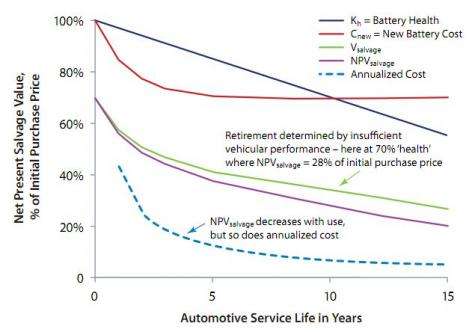April 29, 2011 report
New uses for exhausted electric vehicle batteries proposed

(PhysOrg.com) -- In a move with far and wide consequences for the automobile industry, many groups are banding together to study the two-pronged problem of high initial costs for lithium ion (Li-ion) batteries for electric vehicles, and then what to do with those batteries once they lose their ability to hold a strong enough charge to keep motorists moving. Most proposed solutions center around reusing the batteries in applications that don’t require a battery to be fully chargeable, such as battery backups for an electrical grid; thus allowing the initial cost of the batteries to be spread out over a much longer lifespan.
Currently, customers who are looking to buy an electric car are told that they can expect the battery pack in their new car to last eight to ten years; at which time, they’ll have to replace it at a significant cost to them; no plan has yet been put in place however, regarding what to do with the removed battery packs from the millions of cars that will likely someday be traversing the roads of the world.
Governments, public companies and private environmental groups have all jumped into the fray, each with a different agenda it seems. Governments seek to find alternatives to burning gasoline to relieve their constituents from the vagaries of relying on foreign oil, public companies (particularly those who make cars) want to sell cars (or batteries) at prices customers can afford, and environmental groups want gasoline cars off the road, but at the same time shudder at the thought of mountains of dead batteries littering the landscape.
To deal with this issue, General Motors has forged an agreement with ABB, an energy technology company while Nissan has joined forces with 4R Energy; both hope to find solutions to both problems.
Also the U.S. Department of Energy’s, National Renewable Energy Laboratory (NREL), is teaming up with various academic groups (one of which is the California Center for Sustainable Energy (CCSE)) to find so-called “second life” opportunities for not yet dead batteries. Current possibilities include using them to provide backup support for an electrical grid, or to use them as accessories in capturing power from alternative energy sources such as wind or solar arrays. In such a scenario, it’s suggested that consumers could perhaps lease the batteries in their cars from the manufacture’s, which would mean they’d only have to pay for the useful time they had then; the manufacturer’s could then sell the batteries to utility companies once they’ve been removed from such automobiles, all of which should, in theory, reduce costs for both parties.
Of course in all this, there does exist the possibility that a new battery could be developed; one that might last much longer and would be much cheaper; or another technology, such as hydrogen fuel cells could emerge which would make the whole exercise moot.
Regardless of how the current type of batteries are used, however, there will still come a time when they will eventually become useless to anyone, which will mean tearing them apart to recycle the viable pieces for recycling purposes; yet another piece of the puzzle that will need to be worked out as the numbers of dead batteries begins to climb.
More information: www.nrel.gov/vehiclesandfuels/ … ge/publications.html
© 2010 PhysOrg.com




















